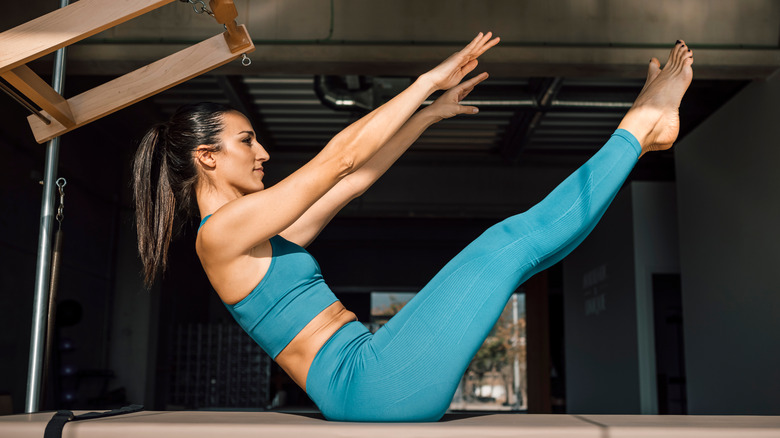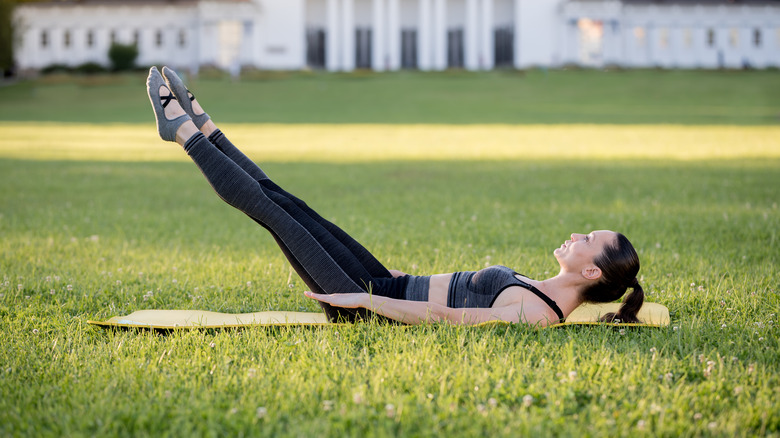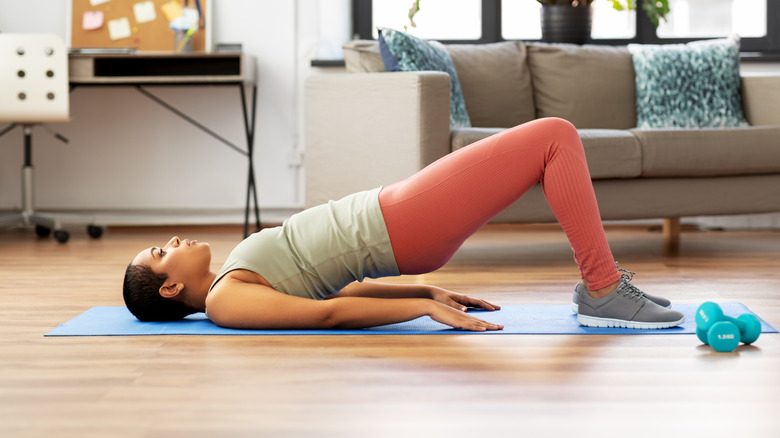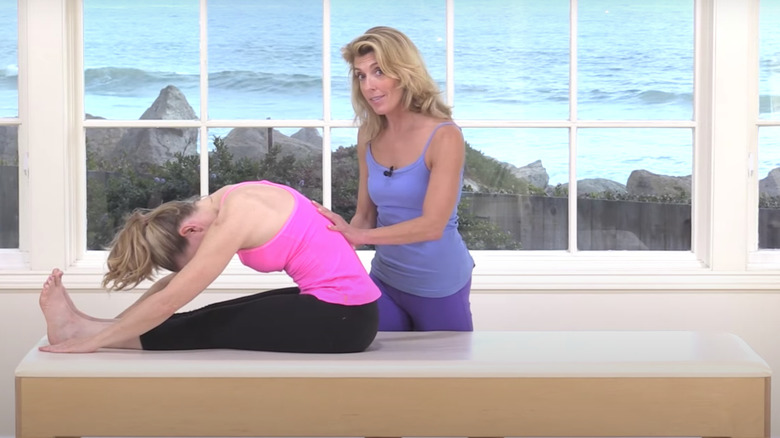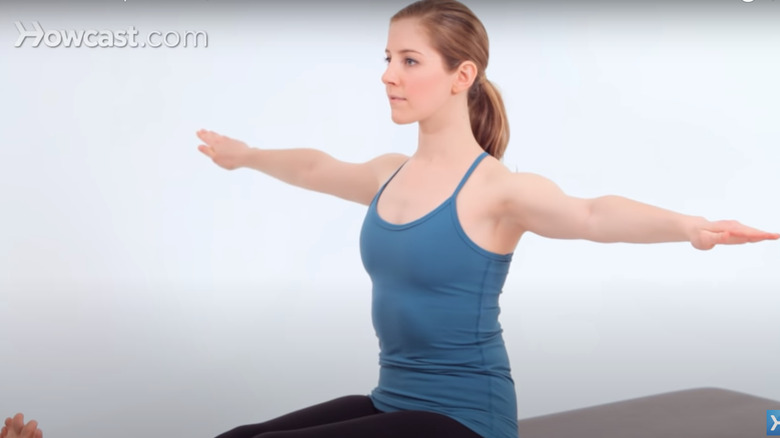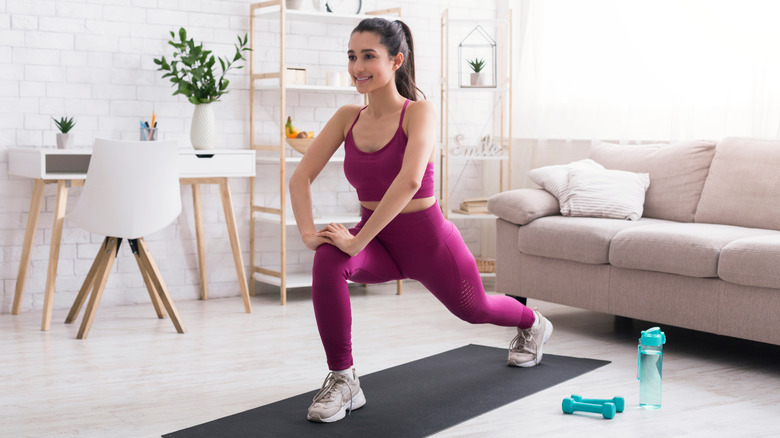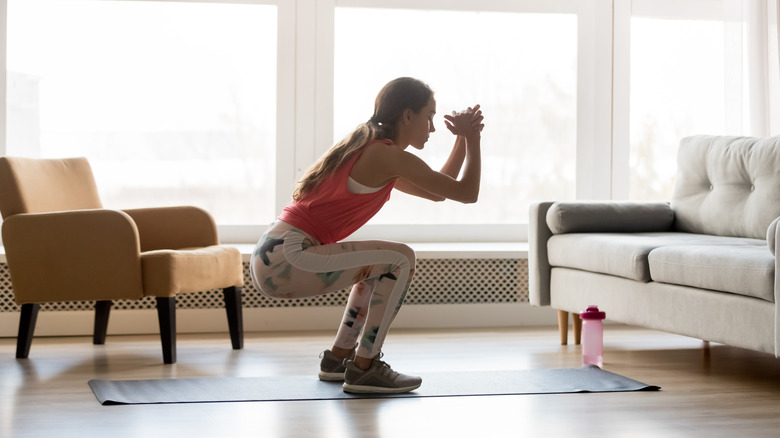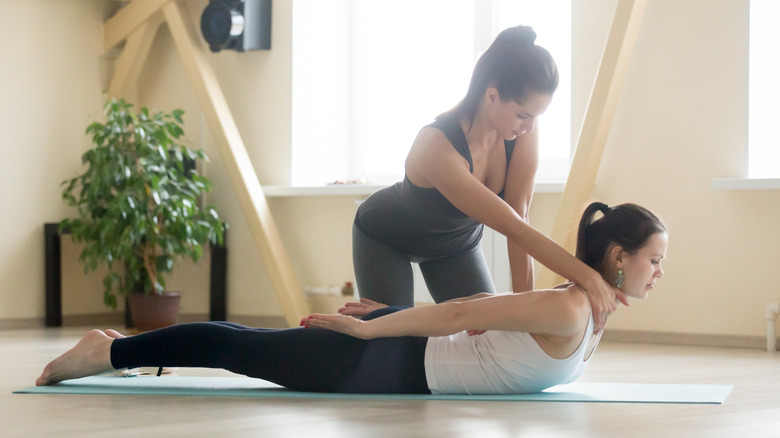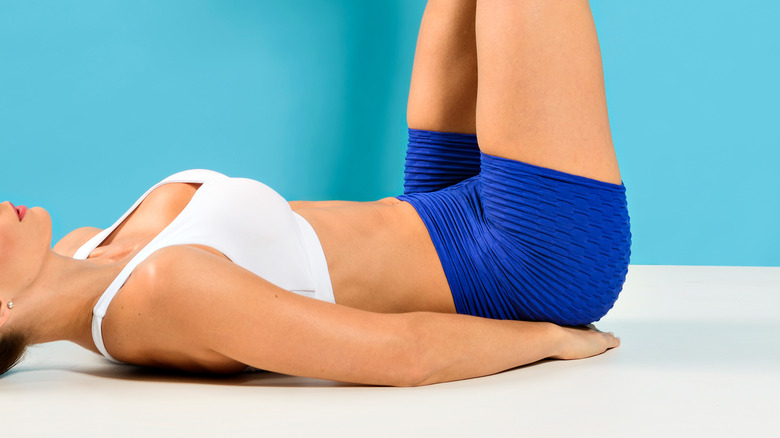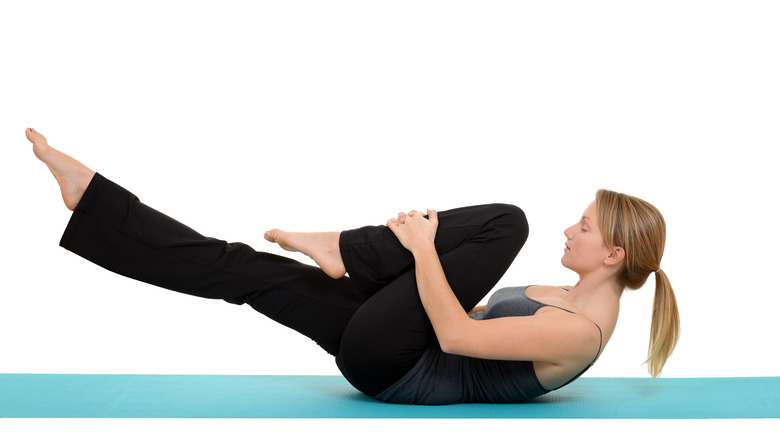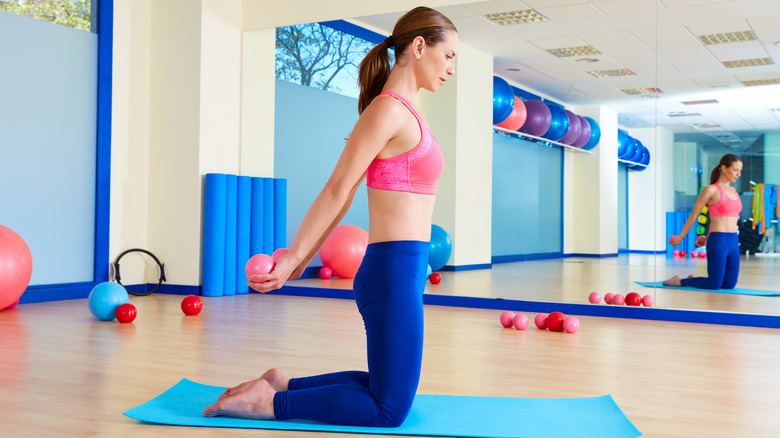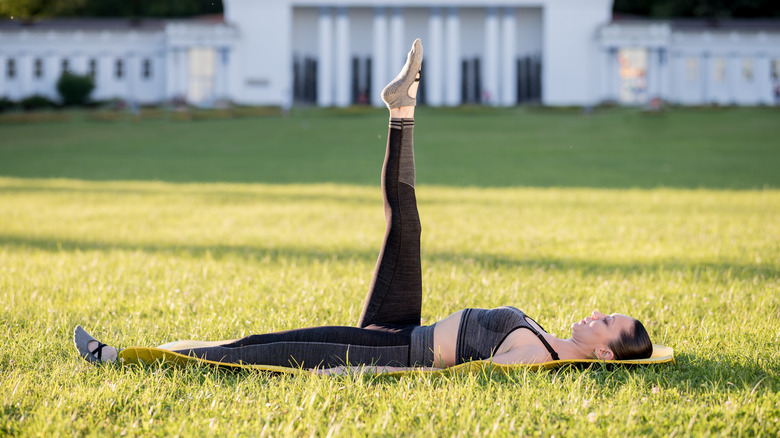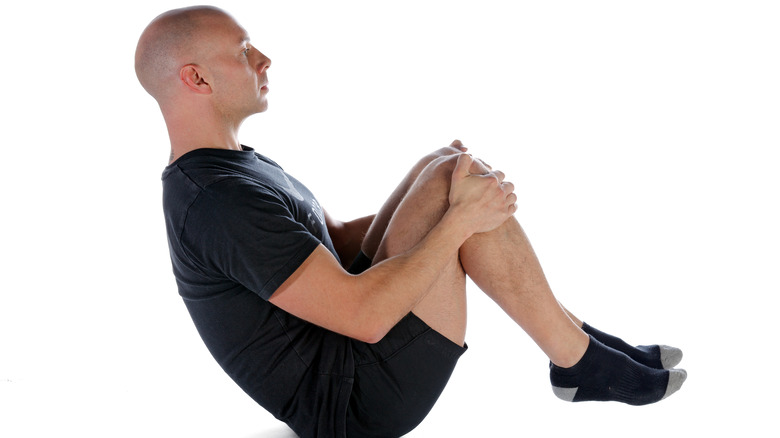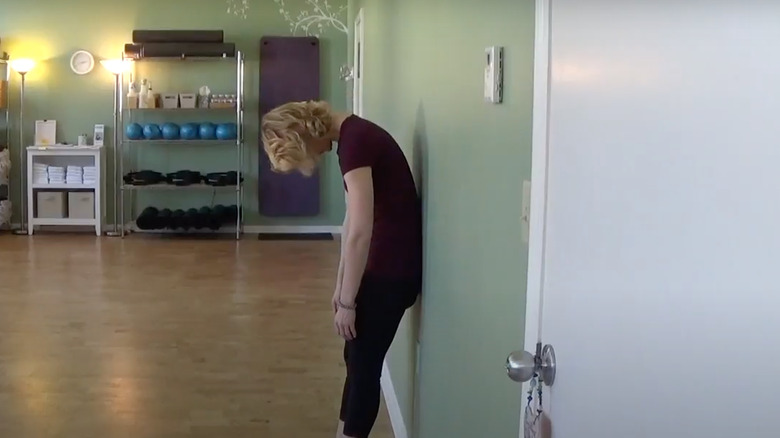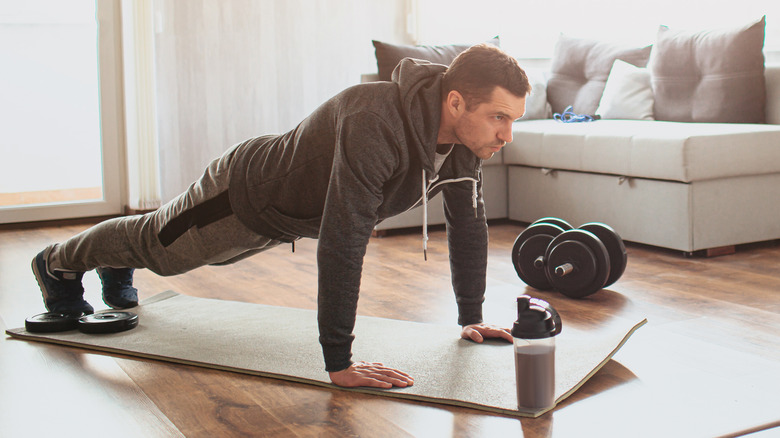Start With These Moves If You're New To Pilates
In the world of fitness, there's one word that's never far from personal trainers' lips: Pilates. Ever since its conception in the 1920s, Pilates has been growing in popularity. Developed by Joseph Pilates as a system of movement to help rehabilitate soldiers injured in the First World War and later identified as a system of exercise that could help with general fitness (according to Women's Health), today Pilates, along with other, more gentle methods of exercise, has become a worldwide phenomenon. In the U.S. alone, the market size of Pilates and yoga studios almost doubled in a decade, reaching $12.82 billion by 2020 (per Statista).
So why is Pilates so popular? Largely because it's so accessible. "It can be tailored to suit any ability level, whether you are just starting out on your fitness journey, or you have been actively exercising for years," claims Pilates-focused Ten Health & Fitness master trainer Brett Starkowitz to Women's Health. Add to that the fact that Pilates can help with everything from building strength and endurance to improving flexibility and reducing injury prevalence, and you're on to a winner with this discipline. And if you're just getting started, we've got the moves you need.
The hundred
It's hard to get more fundamental than the hundred. This classic Pilates exercise is a cornerstone of the practice and is likely to show up in any beginner class, or more advanced session, you partake in, according to Verywell Fit. As a dynamic warmup, the Hundred helps to initiate your abdominals and lungs to a Pilates session through maintaining constant movement and breath during the move, and with modifications possible if you have mobility issues in your neck or back or need things to be easier, it's an exercise anyone can do.
To perform the hundred, lie on the floor on your back in a tabletop position. On an exhale, lift your head, using your abs to help the top of your spine lift and curve away from the floor, keeping your chin tucked in. Inhale, and then exhale again, extending your legs away from you and your arms out by your sides. While in this position, quickly breathe in and out five times, pumping your arms up and down in a controlled movement as you do so. Repeat this cycle for a total of ten breaths in and out. When finished, slowly lower your arms, legs, and head back to the floor. The name comes from the number of times you pump your arms in total. Cool, right?
Pilates bridge
A Pilates bridge is a staple move in any beginner's repertoire. As a move that's simple and safe to do, it helps to supply benefits to muscular strength as well as being a useful exercise to help with injury rehabilitation (per Complete Pilates). Targeting our hamstrings, glutes, and spine erectors, the bridge also helps activate harder-to-reach stabilizer muscles and improve spine mobility in the midsection of the back. It's also particularly beneficial for people who spend all day in a chair, like office workers, who can often be prone to weaker glutes and tighter hip flexors, says Coach. The Pilates bridge helps lengthen out the hip flexors and your hip extension.
Performing a Pilates bridge couldn't be simpler. Lie with your back on the floor with your feet planted firmly on the ground, knees facing skyward and your arms by your side. On an exhale, slowly lift your glutes and lower back off the floor, peeling your spine away until your body is being supported by your shoulder blades and legs. Inhale at the top of the bridge, and then slowly lower your body down, repeating for as many reps as you like. When performing the move, remember not to roll up too high onto your neck, and if you have neck concerns or knee issues, it's useful to speak to a Pilates instructor about whether the move is advisable for your practice.
Roll up
Roll up, roll up, and do this exercise! (Sorry, we couldn't resist). With the abs being heavily engaged in Pilates practice, it's little wonder that this fundamental move has become a go-to for beginners, with the roll up targeting your entire core effectively. "The Pilates roll up is a great exercise, because it's a great ab workout for building strength through your abdominals and is also great for spinal flexion and mobilization," says Go Chlo Pilates founder Chloe De Winter to Well+Good. A strong core not only helps us with essentially every method of exercise out there, but it also helps improve our balance, stability, and posture, and generally supports healthy motion throughout our day-to-day lives (per Harvard Health Publishing).
The roll up may be a move for everyone, but perfecting it takes a little practice. Lie on your back with your legs flat and your arms extended over your head. On an exhale, sweep your arms up, allowing your upper body to peel away from the mat, until your arms are parallel to your legs and your body is curved. If you're finding it difficult to roll up, it might be due to your pelvis being tucked in too much, says Complete Pilates. Your legs coming away from the mat while you roll up is another common problem, but one that can be rectified by keeping your knees bent instead of straight out, which can help reduce your hip flexors getting too involved.
Spine twist
Pilates practice is based around the spine, with the movements in the discipline working with its natural alignment and using motions that help keep its muscular supports strong (per Spine Health). Twist-based movements are a key part of this, and the spine twist is one such basic move that beginners are well-placed to start with. To do a basic spine twist, sit on the floor in an upright position with your legs out in front of you (a small cushion or seat can be placed under your butt if your hamstrings are particularly tight, says Pilates Union). Keep your arms outstretched to either side of your body. Inhale, lengthening your spine as you do so, and then on an exhale twist your body in one direction, engaging your abs while you do so. Return to the center, and then repeat in the other direction.
Spine twists are particularly beneficial for our oblique muscles, the muscles that run either side of our torso and are often neglected for their flashier siblings, the abs. But they still bear attention. "It is so important to train and build strong obliques muscles to help us perform better in exercise, sports, and everyday functional movements," states certified personal trainer Danielle Burrell to Self, noting their particular function in keeping our bodies stable.
Standing lunge
A standing lunge is a standard move in a plethora of exercise regimes, and in Pilates, it's pretty much used from day one. While lunges can be performed in a variety of variations for a multitude of purposes, during Pilates they target the major lower-body muscles while also effectively stretching out your hip flexors, says Verywell Fit. In addition to helping strengthen your leg muscles, your core and lower back are also engaged and your balance is tested, all in one move. We love that.
While most people know how to perform a standing lunge, it's always worth a reminder. Standing with your feet parallel and hip-width apart, step one foot forward, with your front foot landing flat on the floor (per Healthline). Bend your front knee forward to approximately a 90-degree angle, allowing your back foot's heel to come off the ground, with the back leg remaining straight. There are a few key errors to watch out for during this move, and focusing on your form is essential. Ensure that your front leg and knee don't extend beyond your foot when you're in a full lunge, and that your knee and ankle are aligned at your lunge's lowest point. Make sure, too, that your hips remain parallel and don't sag to the left or right while you're in the lunge, or that they don't drop too far toward the floor.
Narrow squat
A narrow squat is a slightly more advanced move for Pilates, but it's still perfectly doable for beginners and provides a host of benefits. Targeting the quads as the primary muscles, and the glutes and hamstrings in a secondary manner, a narrow squat is a variation on a classic squat and can be performed with a variety of variations, should you want to amp up the difficulty, according to Exercise.
For a narrow squat, begin by putting your feet together, facing forward. On an inhale, slowly lower your upper body, bending at the knees, keeping your eyes forward, until your glutes are parallel with the floor. Hold for a few seconds, and then exhale as you drive back up to your starting position. To increase the intensity of the move, try pulsing at the bottom of the squat, moving slightly up and down, to activate your muscles even more.
Letter T
It can sometimes be difficult to know how to work on our upper backs without using heavy weights or gym equipment, but it's important to find methods to do so even in gentler practices. Maintaining upper back strength is particularly important as we age, due to its effects on supporting correct posture and keeping the spine lengthened, according to Lifetime Daily. Keeping your upper back activated also allows you to maintain muscle mass, helping to work against any age-related loss.
In Pilates, a range of moves target your back, and one of the most effective is the Letter T, which can be performed without a reformer, as WebMD states. Lie on the floor on your front, with your feet together and your arms out on either side, palms facing down. Lift your chest and head up slightly, and raise your arms so that they're perpendicular to your body in a T shape. On an exhale, pull your arms back toward your legs, engaging your upper back muscles as you move them into a parallel position to your body, allowing your head and chest to lift a little more as you do so. Inhale to return to the starting position.
Practice your scoop
When embarking on Pilates training, it's important to understand its key concepts, to make your exercise the best it can be. One of these is the scoop. Although the scoop isn't an exercise in itself, it's a readying move that gets you prepared to perform other Pilates moves with safety and effectiveness. The key postural movement requires you to pull your stomach "in and up, so you activate the deep postural or stabilizing muscles such as the transversus abdominus and pelvic floor," says director of Restore & Reform Lucy Nifontova to Women's Health. This gives your core additional strength and keeps your lower back muscles long, giving your Pilates training greater freedom of movement, per Centerworks.
The scoop can be done lying on your back, standing up, or on your hands and knees (per Effortless Movement). If standing, Women's Health advises doing it with visualization. Imagine that you're wearing a pair of button-up jeans, with the lowest button resting by your pubic bone and the highest at your belly button. With your thumbs resting by your belly button and your fingers facing toward where the lowest button would be, imagine that the low button is moving up toward the highest one, allowing your body, pelvis, and spine to move naturally. If lying down, your knees should be bent, with hands and feet flat on the floor, says Centerworks. On an exhale, contract your lower abs and allow your lower back and sacrum to connect with the floor.
Single leg stretch
Although many Pilates movements seem to isolate certain parts of the body, it's useful to remember that whatever you're doing, moving from your core is an essential aspect of the practice (via Self). It's important, therefore, to train your body to do this as a beginner. The single leg stretch is a great way to do so, with your abs providing stability while your legs and arms do the visible moving (per Verywell Fit). To perform the move, begin in the tabletop position on the floor. On an exhale, slightly curl your head and shoulders up, and extend one leg out, with your hands coming to the leg still close to the body, drawing it in a little. Breathing in, and then out, slowly switch legs, repeating 10 times if you can.
Making sure that your form is on-point with this move is essential, as the single leg stretch works as the basis for more advanced Pilates procedures. Importantly, there shouldn't be any additional movement through your core or torso during the stretch, with only your legs and arms in action. Given that this is a movement performed on your back, there's a risk of placing too much strain on your neck, so if you're feeling pulling or strain, simply lower your head back onto the mat. Conversely, if you feel the strain in your lower back, move your legs a little higher.
Chest expansion
Starting Pilates requires some of us to take on a different approach to exercise and our bodies. For some, this requires a shift away from pumping iron in the gym, and toward a more holistic focus on movement. "Men in particular traditionally work their muscles in isolation a lot, while classical Pilates has a flow to it, mobilizing the joints through every exercise," states Exhale Pilates London owner Gary Noble to Coach. Noble recommends the chest expansion exercise for beginners to the practice, which works your elbow and shoulder extensors while also activating through the core and neck.
Start in a kneeling position, with your thighs perpendicular to the floor and your spine fully extended. Introducing tension into your arms and keeping your core activated, slowly pull them behind you, with your palms facing toward the back wall and your shoulder blades coming together. When your arms are back, slowly turn your head to face over one shoulder, then the other, pausing in the middle. Once your head is central, allow your arms to come back to your starting position, and repeat for as many reps as you wish.
Leg circles
Beginners be warned here. Leg circles may seem easy (and they're a staple of most Pilates practices), but they can be trickier than you think to nail, according to certified strength and conditioning specialist Erica Suter via Openfit. Despite this, putting in the effort to get this move just right will pay off down the line, not only in your Pilates workouts but in your body, too. As Suter says, "Leg circles crush the glutes, especially the hip abductors," an area of the body that's traditionally quite difficult to train (per Healthline). Leg circles also get your hip flexors involved and activate your core muscles, meaning that this is an exercise you'll want to master.
To do leg circles, lie flat on your back with your palms flat on the floor by your sides. Pointing your toes, slowly raise one leg up so it's pointing at the ceiling. Keeping your core engaged, gently circle your leg clockwise, as though you're drawing rings with your foot, for as many reps as desired. Repeat counter-clockwise, and then with the other leg. If you find traditional leg circles too challenging straight off the bat, try side leg circles, performed while lying on your side, giving increased activation to the glutes and outer hip while easing up the focus on your abs. Bent-knee leg circles also take away the burn from your core by introducing a bend in the inactive leg and planting a stabilising foot on the ground.
Rolling like a ball
Turns out, all of those forward rolls you did when you were at school might come in handy if you're starting Pilates. But aside from just being fun, rolling like a ball is a beginner move that's key to any Pilates practice. Rolling like a ball (or rolling back) works your abdominal muscles and the other muscles in the Powerhouse. As Pilates founder Joseph Pilates proposed, the Powerhouse is made up of your abdominal, hip, butt, and lower back muscles, which together are your body's movement center (per True Pilates Sydney Studio). Through engaging all of these muscles, rolling like a ball helps to build a better foundation for functional movement and strength. To do the move, sit with your shins tucked into your chest, hands on knees. Pull your feet away from the floor, and in a ball shape, roll back on an inhale. Once you've rolled to your shoulder blades, exhale and roll back up.
While the movement is one that many Pilates trainers will champion, it's important to know your limits. Individuals with spine injuries or osteoporosis may struggle with the move, due to the engagement of the spine with the floor during it, says Pilates Anytime. Make sure that you're performing the move slowly, too — you don't want to roll back too forcefully and make contact with the floor with your head and neck.
Wall roll-down
While many Pilates techniques are about building strength, it's also a system of exercise that can help us feel freer in our movements. "Oftentimes, people feel that their body has been compressed, tense, and tight beforehand but leave the studio feeling more loose and more aware of their body," says BK Pilates founder Marina Kaydanova to Women's Health.
Incorporating beginner movements that are specifically designed to loosen and lengthen the spine and relax muscles can help with this, and the wall roll-down is a gem of an exercise to do so. And it couldn't be simpler. Simply stand with your back body against a wall, your feet positioned slightly forward (per Coach). Take a few deep breaths, circling your arms in front of you as you do so, and then slowly start to allow the weight of your head to draw your body down forward. Peel your back away from the wall vertebrae by vertebrae, until you're hanging forward from your pelvis. Give your body a little shake at the bottom, and then slowly roll your body back up, connecting your back with the wall. Repeat for a few reps.
Plank
You'd be hard-pressed not to find a plank in most workout routines, so it's no big surprise it's a key feature in Pilates too. Planks are pretty much the gold standard of exercise moves, with the benefits of the position extending beyond working your core and activating your glutes, quads, arms, and shoulders, according to personal trainers Candace Rhodes and Ashley Dean via Real Simple. Aside from their next-level strengthening capacity, planks can also help you rehabilitate from injuries, improve and correct posture, and boost your balance, and its spine-friendly and core-strengthening combo mean that it can also help people who experience lower back pain.
For a pilates plank, start on your hands and knees, with your hands planted under your shoulders and your fingers pointing forward (per Verywell Fit). Activating through the core, step your legs back until your body is in a straight line, your arms and upper body activated to support. You can also perform a plank on your elbows instead of your hands, by placing your forearms flat on the floor with your hands clasped in front of you. Watch out for arching or sagging when you're in the plank position, says Verywell Fit. Your back arching is a sign that your abdominals aren't engaging sufficiently, whereas your hips sagging down is a sign that your abs are tired. Make sure that your head and neck stay in line with your spine, and that you stay looking towards the floor during the move.

